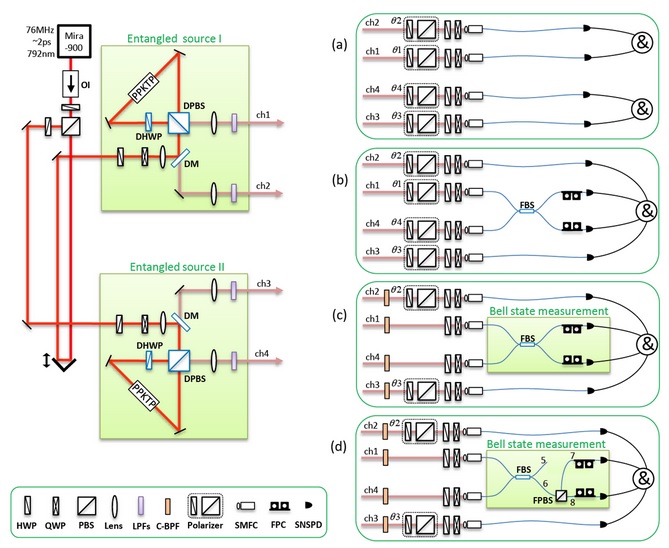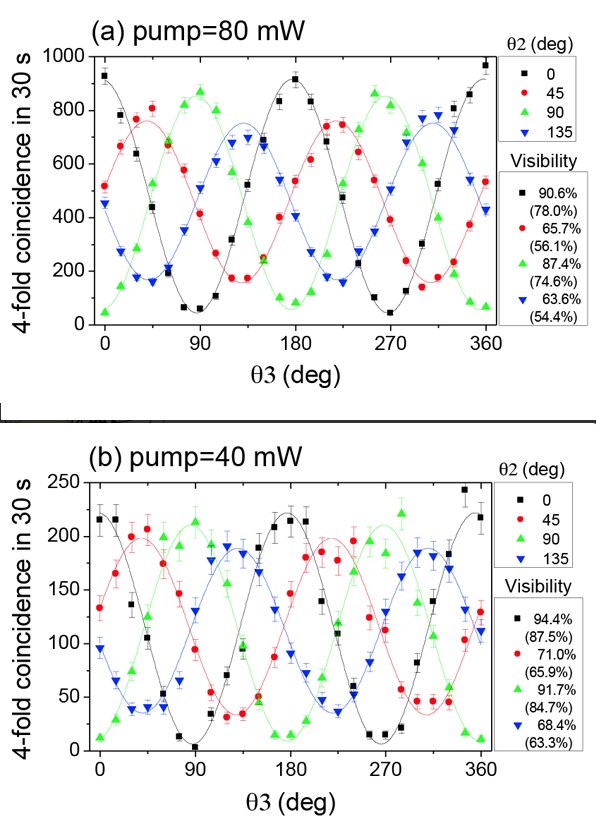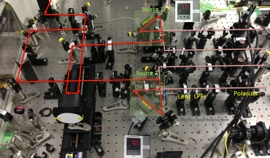March 26, 2015
NICT, in collaboration with the University of Electro-Communications (UEC, President: Dr. Takashi Fukuda), has succeeded in the demonstration of highly efficient entanglement swapping and teleportation at telecom wavelength. We have attained a four-fold coincidence count rate of 108 counts per second, which is three orders higher than the previous experiments at telecom wavelengths. This experiment opens the way to practical implementation of device-independent quantum key distribution and its distance extension by the entanglement swapping as well as multi-photon entangled state generation in telecom band infrastructures with both space and fiber links.

Figure 1: The experimental setup
Picosecond laser pulses (76 MHz, 792 nm, temporal duration of about 2 ps) from a mode-locked Titanium sapphire laser (Mira900) pumped two PPKTP- Sagnac-entangled photon sources.
The photons were detected by superconducting nanowire single photon detectors. (a) is for entangled source test. (b) is for Hong-Ou-Mandel interference test. (c) is for teleportation test. (d) is for entanglement swapping test.
Entanglement swapping at telecom wavelengths is at the heart of quantum networking in optical fiber infrastructures. Although entanglement swapping has been demonstrated experimentally so far using various types of entangled photon sources in telecom wavelength regions, the rate of swapping operation has been too low to be applied to practical quantum protocols, due to the limited efficiency of entangled photon sources and photon detectors.
The researchers have demonstrated drastic improvement of the efficiency at telecom wavelength by using two ultra-bright entangled photon sources and four highly efficient superconducting nanowire single photon detectors. They have attained a four-fold coincidence count rate of 108 counts per second, which is three orders higher than the previous experiments at telecom wavelengths. A raw (net) visibility in a Hong-Ou-Mandel interference between the two independent entangled sources was 73.3% (85.1%). We performed the teleportation and entanglement swapping, and obtained a fidelity of 76.3% in the swapping test.

Figure 2: The entanglement swapping results
(a) with 80 mW pump power for entangled source I (II). (b) the power was reduced to 40 mW for entangled source I (II). The background subtracted visibilities (raw visibilities) are shown on the right side. The error bars were added by assuming Poissonian statistics of these coincidence counts.
Future Prospects
The scheme opens the way to practical implementation of device-independent quantum key distribution and its distance extension by the entanglement swapping as well as multi-photon entangled state generation in telecom band infrastructures with both space and fiber links.
The result was published in Scientific Reports (Nature Publishing Group) on March 20, 2015.
DOI: 10.1038/srep09333
http://www.nature.com/scientificreports
Title: Highly efficient entanglement swapping and teleportation at telecom wavelength
Authors: Rui-Bo Jin, Masahiro Takeoka, Utako Takagi, Ryosuke Shimizu, and Masahide Sasaki













